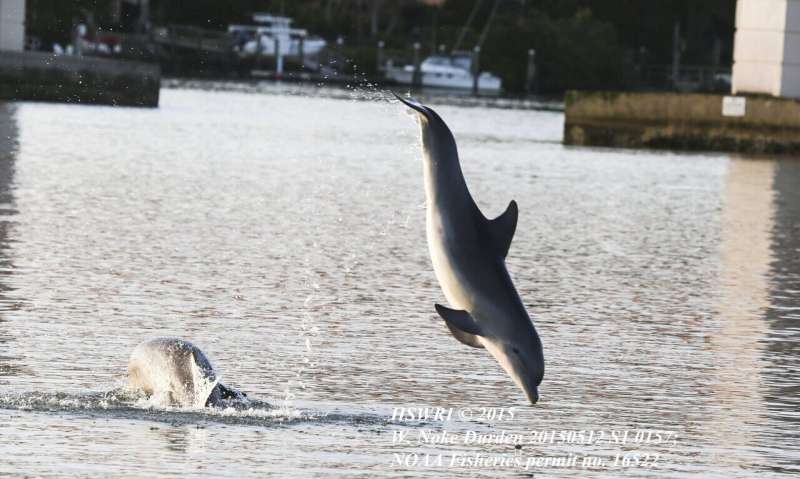Bottlenose dolphins in the Indian River Lagoon along the southeast coast of Florida. Credit: Florida Atlantic University
More than 1,000 bottlenose dolphins live in the Indian River Lagoon year-round. This estuarine system along the southeast coast of Florida is a narrow and convoluted ecosystem with interconnected bodies of water, a handful of ocean inlets, and numerous small rivers, creeks and canals that release freshwater into the lagoon. While this population of dolphins in the lagoon has been studied extensively, what they do at nighttime is still a mystery.
Researchers from Florida Atlantic University's Harbor Branch Oceanographic Institute in collaboration with Seven Degrees of Mapping LLC, and Hubbs-SeaWorld Research Institute, are the first to use satellite telemetry on this dolphin population, providing unique insights into their behavioral ecology during the overnight hours. Detailed information about their nocturnal movements and habitat use will give scientists a more complete ecological understanding of this population. These dolphins face many direct and indirect threats including boat strikes, entanglements, and environmental contamination.
Results of the study, published in the journal Animal Biotelemetry, provide the first documentation of Indian River Lagoon dolphins regularly leaving the brackish waters of the estuarine system and, not only traveling into the ocean, but swimming substantial distances—up to 20 kilometers—up freshwater rivers, creeks, and canals. These journeys do not appear to be extended stays in freshwater, which can be detrimental to dolphin health, but instead involve many brief trips upriver. Findings reveal that they have a larger range that encompasses more habitats than previously thought.
The study also highlights how much variation occurs within a population—researchers found individual differences with almost every aspect studied in these dolphins. Individual spatial use varied by dolphin, with home ranges and core areas of different sizes spaced throughout the southern region of the lagoon. Researchers also discovered extensive individual variation in niche preferences.
Bottlenose dolphins in the Indian River Lagoon along the southeast coast of Florida Credit: Florida Atlantic University's Harbor Branch Oceanographic Institute
"There are many possible reasons for the difference in space use and movement patterns, including prey preference and distribution such as traveling between nearby hotspots versus long distances between food sources or the size or age of the dolphins," said Greg O'Corry-Crowe, Ph.D., project lead and a research professor at FAU's Harbor Branch. "For example, two of the dolphins in our study were smaller and younger, while the other two were larger and older. The differences we observed could also be linked to more complex aspects that are influenced by social factors, differences in predator avoidance strategies, and individual response to human disturbance."
One of the areas showing less variation was inlet use. Three out of four dolphins exhibited a strong nocturnal preference for habitats close to inlets, with one individual regularly using multiple inlets. Inlets may be important nocturnal foraging habitats as well as corridors for movement between ecosystems.
Satellite telemetry is a powerful research tool that tracks the movement of an animal using orbiting satellites that detect signals emitted from a transmitter attached to the animal. For the study, the researchers attached satellite tags (SPOT 100 tags, Wildlife Computers) on the lower third of the trailing edge of the dorsal fin of four male dolphins, aged 6 to 21 years. The satellite tags recorded location data via the Argos satellite system. The tags were set to transmit constantly until 250 transmissions were reached in each 24-hour cycle. Satellite tags remained active between 129 and 140 days.
O'Corry-Crowe, Elizabeth F. Hartel, M.S., lead author, Seven Degrees of Mapping LLC, and co-author Wendy Noke Durden, M.S., Hubbs-SeaWorld Research Institute, suggest that incorporating satellite telemetry into long-term studies of bottlenose dolphins in other regions may provide essential information about their movements and habitat use that is not otherwise readily available.
"Collectively, findings from our study highlight the need for greater consideration of the nocturnal habits of cetacean species when conducting risk assessments, developing conservation action, and planning new research," said O'Corry-Crowe.
More information: Elizabeth F. Hartel et al, Testing satellite telemetry within narrow ecosystems: nocturnal movements and habitat use of bottlenose dolphins within a convoluted estuarine system, Animal Biotelemetry (2020). DOI: 10.1186/s40317-020-00200-4
Provided by Florida Atlantic University
























